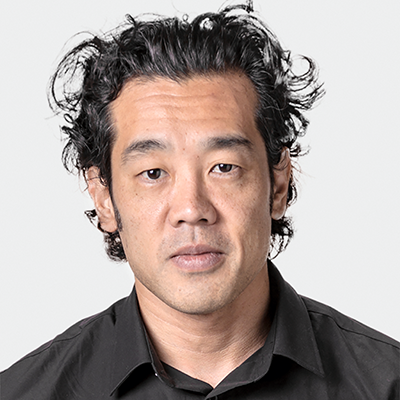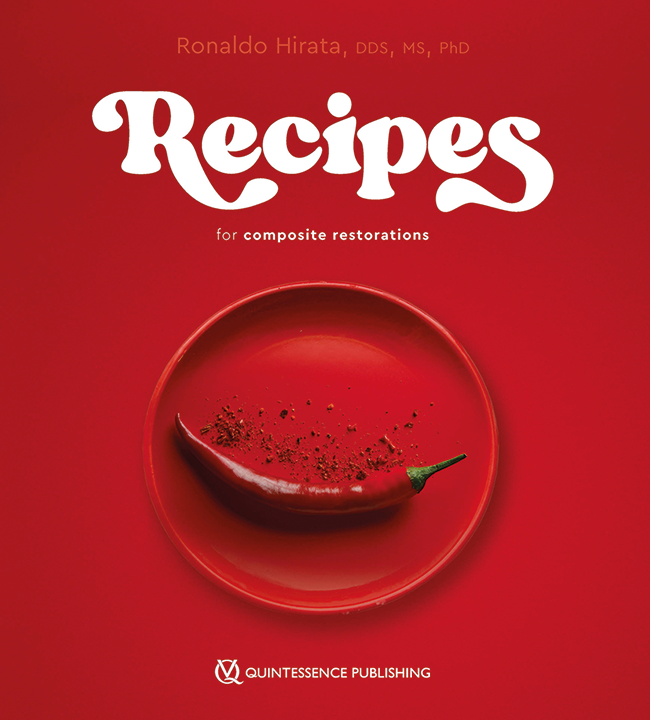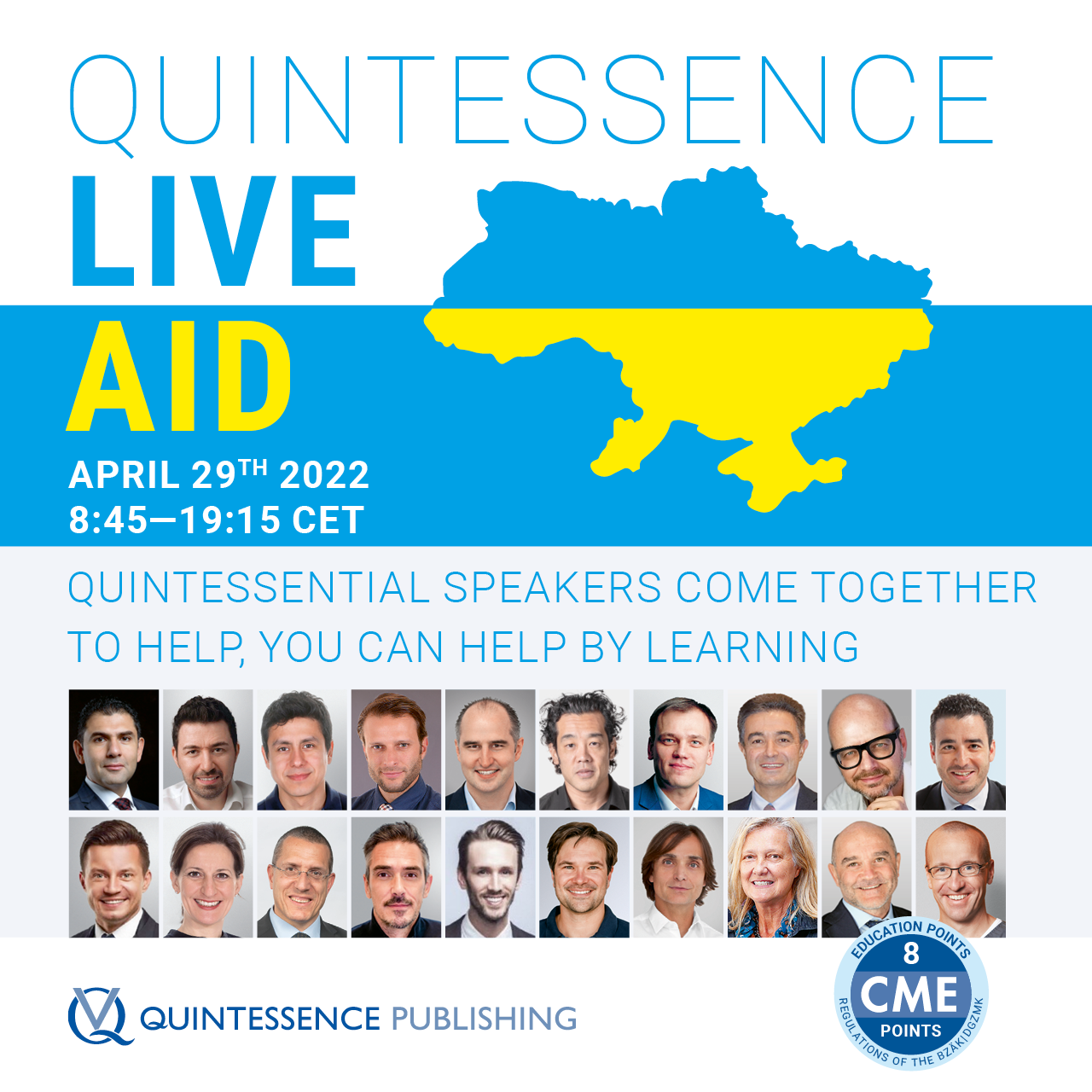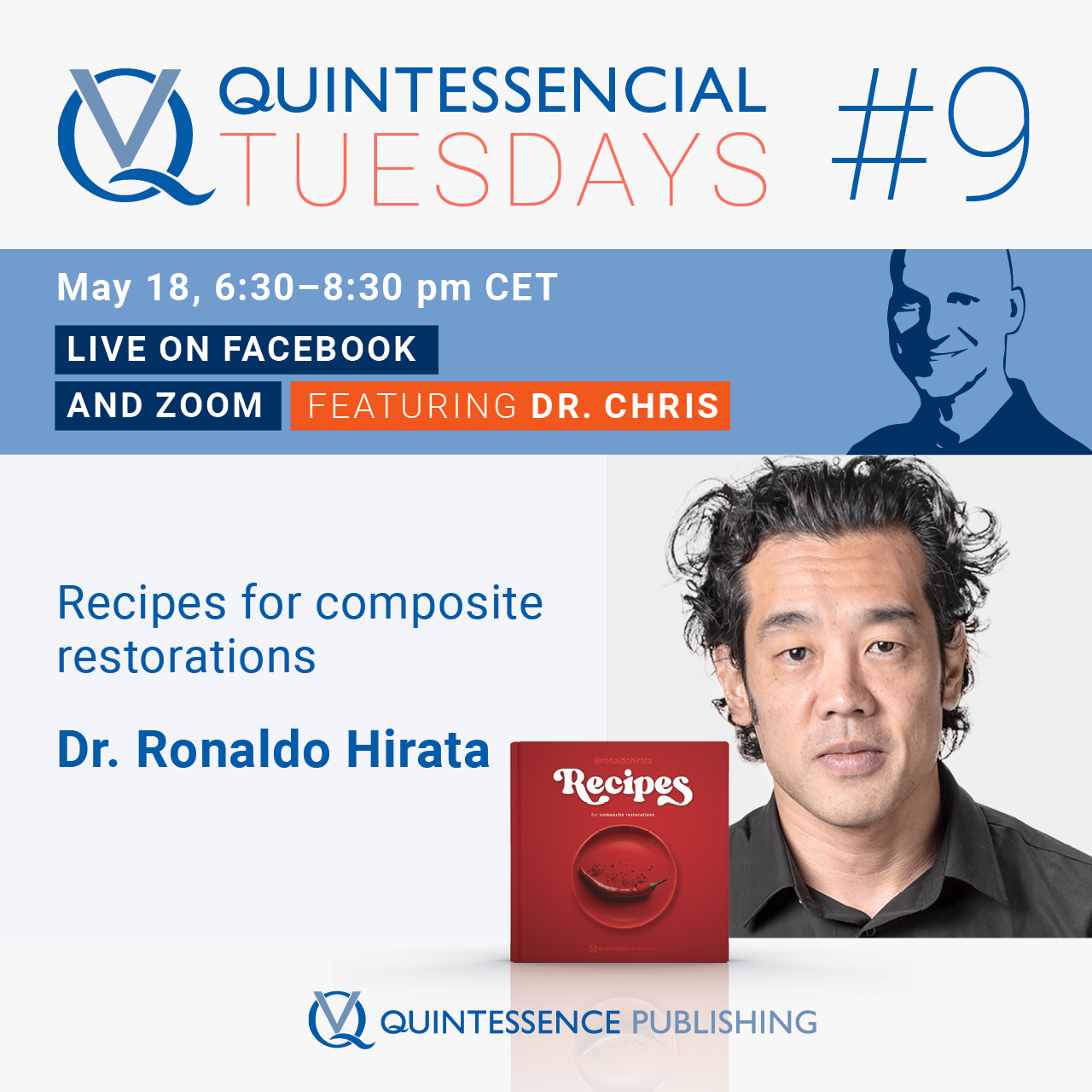Quintessence International, 4/2024
DOI: 10.3290/j.qi.b4994315, PubMed-ID: 38374723Seiten: 286-294, Sprache: EnglischOlcay, Vania / Atria, Pablo / Hirata, Ronaldo / Sampaio, CamilaThis clinical case outlines a comprehensive digital workflow for a minimally invasive multidisciplinary treatment. The process utilizes one open-source software for digital wax-up and one low-cost software to address esthetic concerns related to teeth misalignment. The patient’s function was stabilized with a digitally made occlusal splint. The application of the described digital workflow technique, incorporating open-source, low-cost, and closed software, played a pivotal role in attaining a straightforward and predictable outcome with minimally invasive treatment. Furthermore, the continual evolution of technology contributes to the growing precision of dental procedures. The presented digital workflow helped formulate a predictable treatment plan, replicate a diagnostic digital wax-up, and achieve precise teeth alignment. This approach satisfactorily addressed the patient’s esthetic concerns, providing an outstanding approximation of the definitive result.
Schlagwörter: close software, digital workflow, low-cost software, open-source software, wax-up
International Journal of Esthetic Dentistry (EN), 4/2024
Clinical ResearchPubMed-ID: 39422266Seiten: 312-322, Sprache: EnglischLobo, Maristela Maia / Scopin de Andrade, Oswaldo / Malta Barbosa, João / Sampaio, Camila Sobral / de Castro Folgueras, Diogo / Hirata, RonaldoA 5-year CT evaluation of periodontal healthThe main goal of the modern dentist should be to address the urgent need to promote treatments focused on conservative dentistry, together with maintaining the health of the periodontium. Instead, iatrogenesis that results in the invasion of the biologic space is a significant and increasing problem in dentistry. The present case report illustrates a 5-year computed tomography follow-up of a successful minimally invasive rehabilitation involving ceramic veneers. The study highlights the importance of pretreatment planning as well as a step-by-step clinical execution to achieve long-term health, function, and esthetics, respecting both restorative and periodontal principles.
Schlagwörter: adhesive dentistry, prosthodontics, restorative dentistry
Quintessence International, 3/2022
DOI: 10.3290/j.qi.b2218737, PubMed-ID: 34709774Seiten: 200-208, Sprache: EnglischSoto-Montero, Jorge / Giannini, Marcelo / Sebold, Maicon / de Castro, Eduardo F. / Abreu, João L.B. / Hirata, Ronaldo / Dias, Carlos T.S. / Price, Richard B.T.Objectives: To compare the operative time and presence of air voids on Class II restorations fabricated by dental practitioners with 1 to 5 years of experience using incremental and bulk-filling techniques.
Method and materials: Four techniques were evaluated: incremental, bulk-filling, bulk-filling with heated composite, and snowplow technique. Standardized mandibular first molars with a MOD (mesial, occlusal, and distal) cavity were used. Voluntary operators made two restorations using each technique and the time required for each restoration was recorded. The restorations were scanned by micro-computed tomography to calculate the volume of the restoration occupied by air voids. The “operative time” and “volume of air voids” were analyzed individually by two-way ANOVA and Tukey HSD post hoc (α = .05) for the factors operator and insertion technique. A correlation between “operative time” and “volume of air voids” was evaluated using Pearson coefficient (α = .05).
Results: The incremental technique required significantly longer time, yet no differences were observed between the bulk-filling techniques. There were no significant differences between techniques regarding the volume of air voids. A significant, but weak, and inverse linear correlation (P = .0059; r = −.29; r2 = 8.41%) was found between the operative time and volume of air voids.
Conclusion: There were no significant differences in the volume of air voids among the evaluated techniques, although bulk-filling techniques required a shorter operative time. Hence, implementing bulk-filling techniques by dental schools and restorative dental practitioners with different levels of expertise may reduce chair time and produce a volume of air voids similar to the incremental technique.
Schlagwörter: composite resins, computed tomography, dental materials, dental restoration, filling materials, operative dentistry
Quintessence International, 10/2021
DOI: 10.3290/j.qi.b1901329, PubMed-ID: 34410071Seiten: 904-910, Sprache: EnglischJorquera, Gilbert J. / Sampaio, Camila S. / Bozzalla, Antonia / Hirata, Ronaldo / Sánchez, Juan PabloObjective: To evaluate, in vivo, trueness and precision of two intraoral scanners, CEREC Omnicam (OMNI) and CEREC Primescan (PRIM), compared to a conventional impression serving as a master model.
Method and materials: Impressions were performed for seven participants. For each participant, conventional polyvinylsiloxane impression and digital impressions using two intraoral scanners, OMNI (software 4.6; CEREC ORTHO Protocol) and PRIM (10 digital impressions per participant, per scanner), were made. Conventional impression was digitized with a laboratory scanner (INEOS X5), and used as reference model. .STL files were superimposed with software (Geomagic Control X) using the tools Initial Alignment and Best Fit Alignment, and trueness and precision were evaluated. Statistical evaluation was performed with Shapiro-Wilk and Mann-Whitney tests (P < .05).
Results: Total mean trueness for the OMNI system was 56.45 ± 7.80 µm, and 47.29 ± 5.47 µm for the PRIM system. Regarding precision, values from the OMNI system were 42.47 ± 6.91 µm and from the PRIM system 21.86 ± 4.40 µm. PRIM presented better results for both trueness (P = .000) and precision (P = .000) when compared to OMNI.
Conclusions: PRIM provided a better combination of trueness and precision than its predecessor OMNI. However, both PRIM and OMNI performed acceptably when performing indirect restorations, according to the current acceptable thresholds, considering both trueness and precision. Clinical implications: Full-arch impressions with Primescan presented more precision and trueness than Omnicam; however, compared to previous reported values of conventional impressions, they still presented lower accuracy.
Schlagwörter: digital impression, intraoral scanners, precision, trueness
The Journal of Adhesive Dentistry, 3/2020
DOI: 10.3290/j.jad.a44595, PubMed-ID: 32435773Seiten: 331-333, Sprache: EnglischGiannini, Marcelo / Hirata, RonaldoInternational Academy for Adhesive Dentistry (IAAD) NewsletterInternational Journal of Esthetic Dentistry (DE), 3/2020
Seiten: 358-368, Sprache: Deutschde Abreu, Joao Luiz / Katz, Steven / Sbardelotto, Cristian / Mijares, Dindo / Witek, Lukasz / Coelho, Paulo G / Hirata, RonaldoZiel: Für die Chairside-Herstellung von Kompositrestaurationen werden als Modellmaterial Silikone verwendet. Ziel der vorliegenden Studie war es, vier Modellelastomere hinsichtlich ihrer Fließfähigkeit, Dimensionsgenauigkeit und Reißfestigkeit zu vergleichen.
Material und Methode: Die Materialien wurden in vier Gruppen unterteilt: Mach-2 (M2), Scan Die (SD), GrandioSO Inlay System (GIS) und Impregum (IM). Zur Analyse der Fließfähigkeit diente der Shark-Fin-Test (SFT). Für die Untersuchung der Dimensionsgenauigkeit wurden von der Klasse-I-Präparation eines Prämolaren Abformungen genommen und Elastomermodelle gegossen. Darauf hergestellte Kompositrestaurationen wurden zur Randspaltmessung in den präparierten Prämolaren gesetzt. Die mittlere Randspaltbreite wurde in drei Kategorien eingeteilt: akzeptabel (A), nicht akzeptabel (NA) und Fehlpassung (FP). Um die Reißfestigkeit zu analysieren, wurden streifenförmige Proben mit einer v-förmigen Kerbe hergestellt (n = 6), die in einer Universalprüfmaschine im Reißversuch getestet wurden. Alle Daten wurden mit einem Konfidenzintervall von 95 % statistisch ausgewertet.
Ergebnisse: GIS zeigte die geringste Fließfähigkeit, während zwischen IM, M2 und SD keine signifikanten Unterschiede auftraten. Hinsichtlich der Dimensionsgenauigkeit lieferte IM zu 100 % Randspalte der Kategorie A, gefolgt von M2 mit 80 % sowie SD und GIS mit jeweils 60 %. Bei der Reißfestigkeit fanden sich die höchsten Werte für IM, gefolgt von M2, GIS und SD.
Schlussfolgerung: M2, SD und IM wiesen eine ähnliche, GIS die geringste Fließfähigkeit auf. IM zeigte eine höhere Reißfestigkeit als M2, GIS und SD. Für IM fanden sich am häufigsten akzeptable Spaltbreiten, gefolgt von M2.
International Journal of Esthetic Dentistry (EN), 3/2020
PubMed-ID: 32760928Seiten: 344-354, Sprache: Englischde Abreu, Joao Luiz / Katz, Steven / Sbardelotto, Cristian / Mijares, Dindo / Witek, Lukasz / Coelho, Paulo G / Hirata, RonaldoAim: Die silicone materials are used to build chairside composite restorations. The purpose of this study was to compare the flowability, dimension accuracy, and tear strength of four elastomeric die materials.
Material and methods: Materials were divided into four groups: Mach-2 (M2), Scan Die (SD), GrandioSO Inlay System (GIS), and Impregum-F (IM). Flowability analysis was carried out using the shark fin test (SFT). For dimension accuracy, impressions were taken from a premolar Class I preparation and an elastomeric model was cast. Composite resin restorations were built and positioned into the premolar for gap measurement. The mean gap length was divided into three levels: acceptable (A), not acceptable (NA), and misfit (M). For tear strength, strip specimens were made with a V-shaped notch (n = 6). The specimens were tested in a universal machine until tear. All data were analyzed statistically with a confidence interval of 95%.
Results: GIS showed the lowest flowability values, with no differences between IM, M2, and SD. For dimension accuracy, IM showed 100% 'A' gap values, followed by M2 (80%), SD (60%), and GIS (60%). For tear strength, IM showed the highest values, followed by M2, GIS, and SD.
Conclusions: M2, SD, and IM had similar flowability, while GIS had the lowest. IM presented higher tear strength than M2, followed by GIS and SD. IM showed the highest degrees of acceptable gap filling, followed by M2.
Quintessence International, 8/2019
DOI: 10.3290/j.qi.a42694, PubMed-ID: 31286117Seiten: 604-610, Sprache: EnglischAndreiuolo, Rafael Ferrone / Bittencourt de Abreu, João Luiz / Hirata, RonaldoProper gingival displacement is an important prerequisite to obtain good quality impressions. Retraction pastes could eliminate the need for retraction cords, as they have advantages such as comfort reported by patients, faster technique, ease of use, no need for anesthesia, and reduced tissue trauma. The objective of this paper was to present a clinical case of ceramic veneers and crowns in which a retraction paste was used for gingival displacement during both the impression and cementation stages, with 3 years of follow-up. Treatment planning consisted of the replacement of preexisting crowns and ceramic veneers on the anterior teeth. After finishing the preparations, gingival displacement with Astringent Retraction Paste was performed without anesthesia or the use of cords and the impression was taken. Before cementation of the crowns and veneers, the Astringent Retraction Paste was applied. Avoiding the use of cords during cementation prevented trauma. The soft tissue margins remained stable and healthy after a period of 3 years. It can be concluded that retraction pastes could be indicated for displacement of soft tissue when preparation margins are at the gingival level or slightly intrasulcular prior to impressions, restoration cementations, direct restorations, and before relining provisional restorations. Clinical significance: The impression appointment can be traumatic to some patients. The use of cords for gingival displacement usually requires local anesthesia and is time consuming. Retraction astringent pastes instead of cords seems to be a good option for some cases in gingival tissue displacement.
Schlagwörter: dental ceramics, dental impression materials, dental impression technique, prosthetic procedure, prosthodontics, restorative dentistry
International Journal of Esthetic Dentistry (DE), 4/2019
Seiten: 450-463, Sprache: DeutschLobo, Maristela / de Andrade, Oswaldo Scopin / Barbosa, João Malta / Hirata, RonaldoUnabhängig davon, ob die Patienten intakte oder restaurierte natürliche Zähne, implantatgetragene Restaurationen oder andere Arten von Zahnersatz haben: Die Stabilität und Gesundheit ihrer parodontalen Gewebe sollte ein selbstverständliches Grundanliegen in der Zahnmedizin sein. Ziel dieses Beitrags ist es, die parodontalen Schlüsselaspekte zu diskutieren, die bei der Durchführung adhäsiver oraler Rehabilitationen mit Keramikrestaurationen unterschiedlicher Dicke zu beachten sind. Weiterhin wird die Bedeutung der einzelnen Schritte für die langfristige Bewährung des Behandlungsergebnisses unter parodontalen Gesichtspunkten gezeigt. Der Artikel liefert einen Überblick über die Grundprinzipien der Parodontologie, die direkt oder indirekt für adhäsive Keramikrestaurationen Bedeutung haben, und erläutert ihre klinische Relevanz.
International Journal of Esthetic Dentistry (EN), 4/2019
PubMed-ID: 31549109Seiten: 444-457, Sprache: EnglischLobo, Maristela / de Andrade, Oswaldo Scopin / Barbosa, João Malta / Hirata, RonaldoThe stability and health of the periodontal tissues should be a common goal for all dental care providers with regard to natural or restored teeth as well as implant-supported restorations or any other type of prosthesis. The objective of this study was to address the key aspects to be respected when executing adhesive oral rehabilitations involving ceramic restorations, regardless of their thickness, and to reinforce the importance of each step to ensure the success and longevity of the treatment from a periodontal standpoint. This article reviews the fundamentals of the periodontics that relate directly or indirectly to adhesive ceramic dental restorations, and also addresses their clinical relevance.









